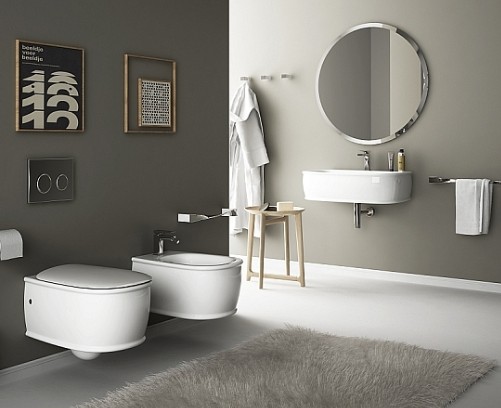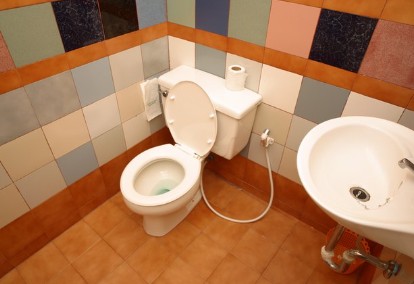With so many terminologies available in the world of bathrooms and different regions using different words to refer to some parts of the bathroom, things can get confusing. In light of that, how does a water closet vs lavatory compare?
A water closet (WC) refers to an enclosed room in a bathroom with a toilet and occasionally a sink. On the other hand, a lavatory is a fixture with basins and sinks primarily used to clean hands. A WC removes human waste, while a lavatory eliminates wastewater used to wash hands or brush teeth.
Understandably, both terms can be confusing, so let’s dig deeper and find out how they differ and put any doubts to rest.

Water Closet Vs Lavatory (A Detailed Comparison!)
| Water Closet (WC) | Lavatory | |
| 1. | It has a toilet and sometimes a sink | It features basins and sinks |
| 2. | The primary parts are a toilet tank, bowl, and seat | The main parts are faucets and bowls |
| 3. | It eliminates human waste with water from a toilet tank | It cleans with water directly from the faucet |
| 4. | It is mainly used for hand washing and teeth brushing | It is primarily used for urinating and pooping |
Water Closet (WC)
A water closet (WC) is a fixture commonly found inside a bathroom to dispose of human waste. It is also usually called a toilet or commode.
A typical water closet consists of a bowl or seat, a water tank or cistern, and a plumbing system that carries away waste to a sewage treatment facility.
Water closets come in different types, including one-piece, two-piece, wall-mounted, and pressure-assisted. They can also come with different features, such as a dual-flush system for water conservation, heated seats, and bidet functions.
Since WC are enclosed, they offer privacy and comfort, allowing you to simultaneously use the bathroom with someone else. For instance, you could relieve yourself while others shower, bathe, or even brush their teeth.
Water closets are an essential fixture in any residential or commercial building, and proper maintenance is necessary to ensure they function efficiently and hygienically. Regular cleaning, periodic inspection, and prompt repair of leaks or malfunctions are recommended to keep a water closet in good working condition.
Lavatory
A lavatory is also called a sink or basin and refers to a fixture found in a bathroom or restroom used to wash hands and face.
Additionally, sometimes a lavatory refers to the whole restroom or bathroom. Typically, a lavatory consists of a bowl-shaped basin mounted on a countertop or vanity, with a faucet that supplies hot and cold water.
Lavatories come in different types, including pedestal, wall-mounted, undermount, vessel, and console. Moreover, they are usually made using materials like porcelain, stainless steel, ceramic, or glass.
You can design your lavatory in different shapes and sizes to fit your needs and bathroom style. You will come across lavatories in commercial and residential buildings to help maintain personal hygiene.
Like washing closets, lavatories require proper maintenance to ensure they function efficiently and hygienically. In that case, regularly clean and inspect them periodically and promptly repair any leaks or malfunctions.
What Is The Difference Between A Lavatory And A Water Closet?
Although water closets and lavatories are both found in bathrooms, they are different fixtures. They differ in what they do, the system of water supply, and the waste disposal type.
Water closets remove human waste, so this is typically where you go to pee, poop, and even vomit when sick or after a night of drinking since its primary feature is a toilet. On the other hand, you use a lavatory to clean your hands, teeth, and face since it has a basin or sink.
The waste in your water closet is washed away by the water in the tank and carried away through your plumbing pipes to a sewage treatment facility. On the other hand, a lavatory is connected to a water supply system and a drain and cleans using water flowing from a faucet.
Basically, a water closet is used for disposing of human waste, while a lavatory is used for washing hands and face. Both fixtures serve essential functions in a bathroom and are often used together in the same room.

Types Of Lavatories
There are several types of lavatories commonly used in residential and commercial settings. They include:
1. Pedestal Lavatory/Pedestal Sink
It refers to a freestanding bathroom sink without a vanity or cabinet underneath. Instead, the sink basin is mounted on a pedestal that supports it and hides the plumbing.
Usually, the pedestal extends from the floor up to the sink’s underside. You will often find pedestal lavatories in small bathrooms or powder rooms with limited space because they require less floor space than a vanity with a sink.
You can also use them to make your bathroom more sophisticated since they look classic and elegant.
2. Wall-Mounted Lavatory/ Wall-Hung Sink
This bathroom sink is attached directly to the wall and has no pedestal or vanity underneath. The sink basin is usually mounted to the wall with brackets or hangers, and the plumbing is concealed within the wall.
You’ll mostly find these lavatories in modern and minimalist bathroom designs because they create a clean and streamlined look.
Additionally, their height can be adjusted to accommodate individuals of different abilities and heights. During installation, ensure the wall can support the sink’s weight and everyone using it.
3. Undermount Lavatory/ Undermount Sink
This bathroom sink goes underneath the countertop rather than on top, secured with adhesive or clips, and the sink’s rim is hidden beneath the counter. While they are popular in modern bathrooms, the countertop material must be compatible with an undermount installation
4. Vessel Lavatory/ Vessel Sink
A vessel lavatory sits on the countertop rather than mounting underneath it or on a pedestal. The bowl-like shaped sink, available in various materials and designs, can be paired with various countertop materials, including granite, marble, concrete, and wood.
You can install it on vanities, countertops, or other custom-designed surfaces to make a statement since they are stylish and functional.
5. Console Lavatory/ Console Sink
Two or more legs or brackets support a console sink rather than mounting it on a pedestal or attached to the wall. Consider a console lavatory for your traditional or vintage bathroom since it looks elegant and classic.
Customization is console lavatories’ biggest advantage as they let you pick the legs or brackets’ style and finish you desire. Also, some console sinks even have a built-in towel bar or storage shelf for added functionality.
6. Drop-in Lavatory
A drop-in lavatory, top-mount sink, or self-rimming sink is a bathroom sink with a rim on the countertop to hold the sink. The installation entails dropping the sink into a hole in the countertop.
Their popularity is attributed to their ease of installation and because they come in various styles and materials. In addition, a drop-in lavatory will cost you less money to buy compared to other sinks.
7. Integrated Lavatory
An integrated lavatory, integrated sink, or integral sink is seamlessly built into the countertop. Usually, the sink and countertop are made of the same material for a cohesive and streamlined look.
They create a clean and minimalist look and have no seams or crevices where dirt and debris can accumulate.
8. Semi-Recessed Lavatory
It’s partially recessed into a countertop or vanity, with the sink’s front side extending out beyond the edge of the countertop. This creates a unique and stylish look that can work well in modern or contemporary bathroom designs.

Types Of Water Closets
Here are the different types of water closets available today.
a) One-Piece WC/One-Piece Toilet
This toilet has the bowl and tank integrated into one unit, creating a seamless and streamlined look that’s easy to clean and maintain. These water closets are popular because they are compact, suitable for smaller bathrooms or tight spaces, and easy to install than two-piece WC.
b) Two-Piece WC/Two-Piece Toilet
The bowl and tank are separate pieces bolted together during installation in these toilets and are the most common toilets in residential homes. Two-piece toilets are usually cheaper compared to one-piece toilets and easier to transport and install.
However, they can accumulate dirt and bacteria in the crevices or gaps between the tank and bowl.
c) Wall-Mounted WC
Wall-mounted water closets, wall-hung toilets, or wall-mounted toilets have the bowl mounted to the bathroom wall and the tank concealed behind the wall or in a separate unit. They are popular because they create a sleek and modern look, make a bathroom feel more spacious, and are easier to clean.
d) Corner WC
This toilet is made to fit into the bathroom’s corner rather than installing it at the center or along a wall, making it a space-saving option. They are available in various styles, such as one-piece and two-piece, and have features like soft-close lids and dual-flush technology.
e) High Tank WC/Pull-Chain Toilet
In this toilet, the tank is high above the bowl and connected by a long pipe or chain. While this design was popular in the late 19th and early 20th centuries, it’s still used in some traditional or vintage-style bathrooms.
f) Smart WC/Smart Toilet
These toiler types incorporate advanced technology and features to provide a more convenient, hygienic, and personalized experience. They have features like bidet functions, automatic flushing, air purification, heated seats, LED lighting, Bluetooth connectivity, and self-cleaning.
g) Dual Flush WC
This toilet has two flush options, one for cleaning liquid waste and another for removing solid waste. It has a larger and smaller button or handle for solid and liquid waste, respectively.
Dual flush toilets conserve water by flushing liquid waste with less water.
h) Pressure-Assisted Water Closet
A pressure-assisted water closet uses compressed air to assist in the flushing process. This toilet has a sealed inner tank with air and water under pressure.
When you flush this toilet, the pressure is released, forcing the water out of the bowl with greater force than a traditional gravity-fed toilet, delivering a more powerful flush.
Final Remarks on Water Closet Vs Lavatory
Despite being different, lavatories and water closets are fundamental parts of a bathroom, serving different but essential functions. Your bathroom needs a toilet to handle liquid and solid waste and a sink to clean your hands and face and brush your teeth.
Also, read:
